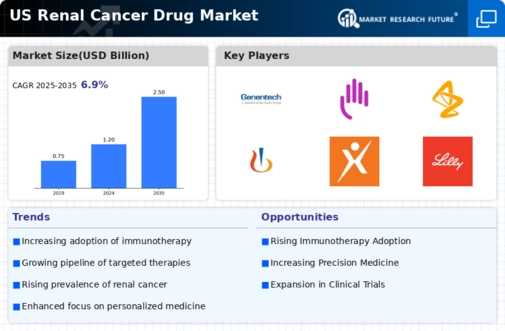Advancements in Precision Medicine
Advancements in precision medicine are significantly influencing the renal cancer-drug market. The integration of genomic profiling and biomarker testing allows for more tailored treatment approaches, enhancing the efficacy of therapies. As a result, patients are increasingly receiving drugs that are specifically designed to target the molecular characteristics of their tumors. This shift towards personalized treatment is expected to drive growth in the renal cancer-drug market, as healthcare providers adopt these innovative strategies. Furthermore, the success of targeted therapies has led to a greater understanding of renal cancer biology, which may encourage further investment in research and development. The potential for improved patient outcomes through precision medicine could lead to a more robust market landscape.
Increasing Incidence of Renal Cancer
The rising incidence of renal cancer in the US is a primary driver for the renal cancer-drug market. According to the American Cancer Society, approximately 79,000 new cases of kidney cancer are expected in 2025, which represents a notable increase from previous years. This growing patient population necessitates the development and availability of effective treatment options, thereby stimulating demand within the renal cancer-drug market. As healthcare providers seek to address this increasing burden, pharmaceutical companies are likely to invest in research and development to create innovative therapies. The heightened awareness of renal cancer symptoms and the importance of early detection may also contribute to the growing number of diagnoses, further propelling the renal cancer-drug market forward.
Rising Investment in Oncology Research
The renal cancer-drug market is growing due to increased investment in oncology research. In recent years, funding for cancer research has surged, with the National Institutes of Health (NIH) allocating substantial resources to renal cancer studies. This influx of capital is likely to accelerate the discovery of new therapeutic agents and treatment modalities. As pharmaceutical companies collaborate with academic institutions and research organizations, the renal cancer-drug market may benefit from innovative approaches and breakthroughs. The increased focus on oncology research not only enhances the understanding of renal cancer but also fosters the development of novel drugs, thereby expanding the treatment options available to patients. This trend suggests a promising future for the renal cancer-drug market as new therapies emerge.
Regulatory Support for Drug Development
Regulatory support for drug development is a crucial driver of the renal cancer-drug market. The US Food and Drug Administration (FDA) has implemented various initiatives to expedite the approval process for new cancer therapies, including renal cancer drugs. These initiatives aim to bring innovative treatments to market more quickly, thereby addressing the urgent needs of patients. The FDA's commitment to facilitating access to effective therapies may encourage pharmaceutical companies to invest in the renal cancer-drug market. Additionally, the potential for accelerated approvals and priority review designations could lead to a more dynamic market landscape, as new drugs become available to patients in a timely manner. This regulatory environment appears to foster innovation and growth within the renal cancer-drug market.
Growing Awareness and Screening Initiatives
Growing awareness and screening initiatives are contributing to the expansion of the renal cancer-drug market. Public health campaigns aimed at educating individuals about the risk factors and symptoms of renal cancer are likely to lead to earlier diagnoses. As more people become aware of the importance of regular screenings, the number of diagnosed cases may increase, subsequently driving demand for effective treatments. Healthcare providers are also emphasizing the need for routine check-ups, which may result in a higher detection rate of renal cancer. This proactive approach to cancer management could create a more favorable environment for the renal cancer-drug market, as pharmaceutical companies respond to the increased need for therapeutic options.

















Leave a Comment